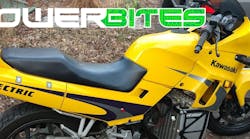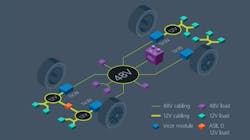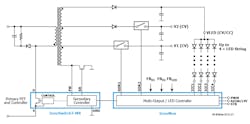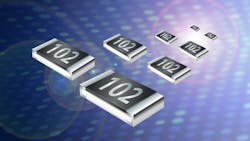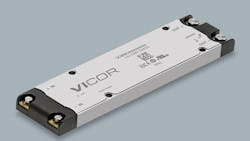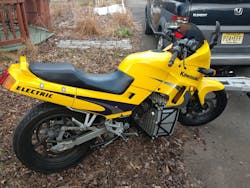>> Electronic Design Resources
.. >> Library: Article Series
.. .. >> Article Series: PowerBites
Are Decentralized 48V Systems the Future of Automotive Power? A Free White Paper
Will moving automotive power systems from 12 V to 48 V be enough to meet the needs of modern vehicles, or is it time to completely rethink a distribution architecture that has remained virtually unchanged since the 1930s? Vicor's white paper," Solving automotive electrification challenges via a decentralized 48V power architecture" makes a strong case for the savings and efficiency gains available from the new architecture, especially in so-called "mild hybrid" vehicles, which represent a growing percentage of new vehicle designs. While it's clear that the white paper was written to promote this approach to 48-V systems, it's heavy on information and relatively light on propaganda—well worth your time if you're involved with automotive power. Click here to register and download.
Switcher ICs Use GaN to Deliver 91% Efficiency, Shrink Cost and Form Factors for Display PSUs to 75 W
Power Integrations expanded its InnoSwitch 3-MX isolated switcher IC family with the addition of three new PowiGaN devices. As part of a chipset with the company’s InnoMux controller IC, the new switcher ICs now support display and appliance power-supply applications with a continuous output power of up to 75 W without a heatsink.
The InnoMux chipset employs a unique single-stage power architecture that reduces losses in display applications by 50% when compared to conventional designs, increasing overall efficiency to 91% in constant-voltage and constant-current LED backlight driver designs. The design eliminates the need for post-regulation stages, allowing TV and monitor designers to halve component count.
InnoSwitch3-MX flyback switcher ICs combine the primary switch, the primary-side controller, and a secondary-side synchronous rectification controller. Communication between the controller and the switch ensures precise control of output voltage or current. Samples of the INN3478C, INN3479C, INN3470C InnoSwitch3-MX ICs are available now with prices starting at $2.52, $3.14, and $3.71, respectively, in 10,000-piece quantities. Technical support for the chipset is available from the Power Integrations website at https://ac-dc.power.com/products/innomux-family/
AEC-Q200-Compliant Thick-Film Resistor Series Target General-Purpose Apps
Bourns’ latest addition to its Model CRxxxxA series of AEC-Q200-compliant thick-film chip resistors features rated power from 0.05 to 1 W and a wide resistance range from 1 Ω up to 20 MΩ. They come in eight compact form factors, as small as 0201. These features make the series an optimal circuit-conditioning solution for a broad range of consumer, industrial, telecom, and other applications. They’re available in five different versions to support specific application requirements: CR standard, CR-PF ultra-low lead content, CR-AS sulfur resistant, CRxxxxA-AS AEC-Q200-compliant and sulfur resistant, and CRxxxxA AEC-Q200-compliant. Click here for more information.
270- to 28-V DC-DC Converter Offers 1300 W at 96% Efficiency
Vicor's DCM5614, an isolated, regulated 270- to 28-V dc-dc converter, delivers an output power rating of 1300 W. It comes in a 5.6- × 1.4- × 0.3-in. VIA package, boasting an exceptionally high power density of 451 W/in.3, and weighs just 178 g. The DCM5614 is designed specifically for advanced airborne, shipboard, and UAV systems where power density, weight, and efficiency are critical.
With 96% efficiency, power dissipation is significantly reduced, and the innovative planar and thermally adept VIA package enables multiple cooling strategies for enhanced thermal performance. Modules can also be easily paralleled for greater power or stacked for increased output voltage. Learn more about the Vicor DCM5614 by clicking here.
What's Yellow, Silent, Cheap, and Goes 0-60 in Under 4 Seconds?
While you might be tempted to imagine a turbocharged banana, the answer is actually lurking in my garage. My first all-electric vehicle is an older Kawasaki Ninja whose seized engine has been replaced with a honking-powerful brushed dc motor and a stack of cells salvaged from a Nissan Leaf. I acquired it from a fellow electrical engineer who built it about eight years ago and is moving on to other projects. Besides being frighteningly fast, it has a simple robust design, but in need of new batteries and some technical updates. I'll be writing about the bike, and my plans for it in what I hope to be the first of a series of blogs that will appear here in Electronic Design.
>> Electronic Design Resources
.. >> Library: Article Series
.. .. >> Article Series: PowerBites
